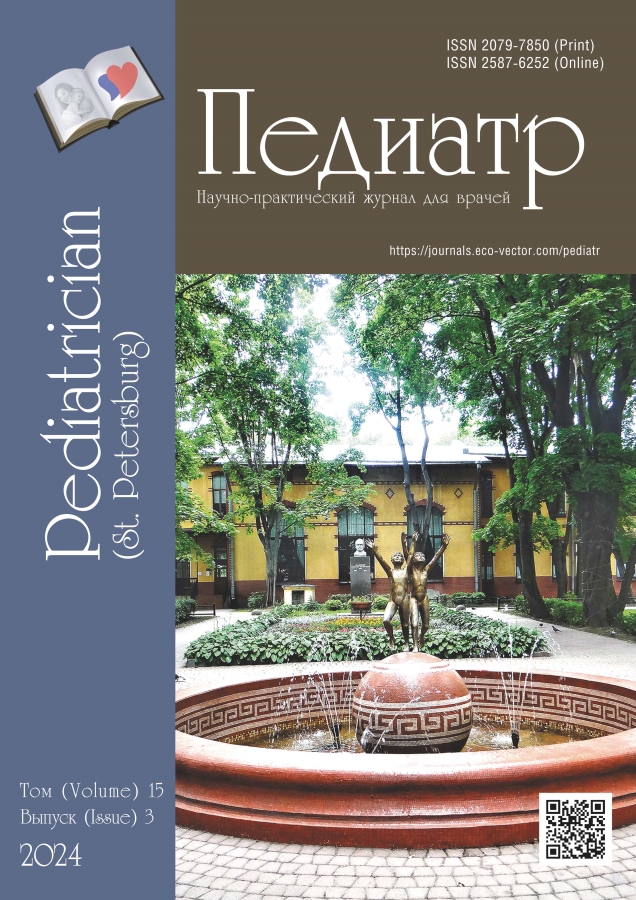Nevus comedonicus. Clinical case
- Authors: Artykova A.A.1, Mineeva O.K.1, Leina L.M.1, Milyavskaya I.R.1, Gorlanov I.A.1, Bolshakova E.S.1
-
Affiliations:
- Saint Petersburg State Pediatric Medical University
- Issue: Vol 15, No 3 (2024)
- Pages: 65-70
- Section: Clinical observation
- URL: https://journals.eco-vector.com/pediatr/article/view/642126
- DOI: https://doi.org/10.17816/PED15365-70
- ID: 642126
Cite item
Abstract
Nevus comedonicus is a rare benign hamartoma of the sebaceous follicle which is more common on the face, neck, shoulders, chest or abdomen. Nevus is group of small or large open comedones. It is a type of organoid epidermal nevus and usually appears before the age of 10 years. The linear configuration of the lesion along Blaschko’s lines suggests that the nevus is a manifestation of mosaicism. A possible cause of nevus comedonicus is mosaic postzygotic mutation of the NEK9 gene. Nevus comedonicus syndrome is also associated with extracutaneous abnormalities. Extracutaneous manifestations most often include ocular abnormalities: ipsilateral cataracts and corneal changes. Associated skeletal abnormalities include abnormalities of the fingers/toes (polysyndactyly or clinodactyly, etc.), scoliosis and other spinal malformations. We present our patient with a large nevus comedonicus localized on the left half of the abdomen with transition to the thigh. The lesion consists of multiple densely located elements with a diameter up to 1–2 mm in the form of expanded orifices of hair follicles — open comedones and inflammatory nodes. Scars remain in place of resolved nodes. A feature of the nevus in our patient is the large size of the nevus and the presence of inflammatory nodes. Dermoscopy reveals numerous light and dark brown, round or barrel-shaped, homogeneous areas with protruding keratin plugs. The treatment was carried out at the clinic with minocycline and gel adapalene externally. Thus, comedo nevus is a rare skin pathology that usually appears at birth and can affect any area of the skin. It can be an isolated skin pathology or as a component of comedo nevus syndrome, which requires additional examination of patients.
Full Text
About the authors
Anna A. Artykova
Saint Petersburg State Pediatric Medical University
Email: anna.artykova95@mail.ru
ORCID iD: 0000-0003-2845-1797
SPIN-code: 3981-0739
Dermatovenereologist, Clinic of Dermatovenerology
Russian Federation, Saint PetersburgOlga K. Mineeva
Saint Petersburg State Pediatric Medical University
Email: o-mine@ya.ru
ORCID iD: 0000-0002-6063-481X
SPIN-code: 3906-3813
Dermatovenereologist, Clinic of Dermatovenerology
Russian Federation, Saint PetersburgLarisa M. Leina
Saint Petersburg State Pediatric Medical University
Author for correspondence.
Email: larisa.leina@mail.ru
ORCID iD: 0000-0002-4652-6732
SPIN-code: 4223-4932
MD, PhD, Associate Professor, Department of Dermatovenerology
Russian Federation, Saint PetersburgIrina R. Milyavskaya
Saint Petersburg State Pediatric Medical University
Email: imilyavskaya@yandex.ru
ORCID iD: 0009-0002-6384-3171
SPIN-code: 4775-5178
MD, PhD, Associate Professor, Dermatovenerology Department
Russian Federation, Saint PetersburgIgor A. Gorlanov
Saint Petersburg State Pediatric Medical University
Email: gorlanov53@mail.ru
ORCID iD: 0000-0001-9985-6965
SPIN-code: 1195-6225
Dr. Sci. (Medicine), Professor, Head of Dermatovenerology Department
Russian Federation, Saint PetersburgElena S. Bolshakova
Saint Petersburg State Pediatric Medical University
Email: Bolena2007@rambler.ru
ORCID iD: 0000-0003-3138-7116
SPIN-code: 3575-9521
Head of Dermatovenerology Department
Russian Federation, Saint PetersburgReferences
- Avanesyan RI, Avdeeva TG, Alekseeva EI, et al. Pediatrics: national manual. Vol. 1. Moscow: GEOTAR-Media; 2009. 1024 p. (In Russ.)
- Gorlanov IA, Leina LM, Milyavskaya IR, et al. Epidermal nevi and epidermal nevus syndromes in pediatric practice (literature review). Pediatrician (St. Petersburg). 2022;13(6):73–84. EDN: QTZRCL doi: 10.17816/PED13673-84
- Kuleva SA, Khabarova RI. The role of dermatoscopy in skin neoplasms diagnostics in children and adolescents. Pediatrician (St. Petersburg). 2023;14(2):79–91. EDN: GLOFLQ doi: 10.17816/PED14279-91
- Al-Balas M, Al-Balas H, Alshdifat S, Kokash R. Nevus comedonicus: A case report with the histological findings and brief review of the literature. Int J Surg Case Rep. 2023;105:108021. doi: 10.1016/j.ijscr.2023.108021
- Asch S, Sugarman JL. Epidermal nevus syndromes: New insights into whorls and swirls. Pediatr Dermatol. 2018;35(1):21–29. doi: 10.1111/pde.13273
- Diniz GRB, Bittencourt FV. Extensive unilateral nevus comedonicus with an inflammatory component. An Bras Dermatol. 2023;98(1):112–114. doi: 10.1016/j.abd.2021.01.012
- Engber PB. The nevus comedonicus syndrome: a case report with emphasis on associated internal manifestations. Int J Dermatol. 1978;17(9):745–749. doi: 10.1111/ijd.1978.17.9.745
- Ferrari B, Taliercio V, Restrepo P, et al. Nevus comedonicus: a case series. Pediatr Dermatol. 2015;32(2):216–219. doi: 10.1111/pde.12466
- Guldbakke KK, Khachemoune A, Deng A, Sina B. Naevus comedonicus: a spectrum of body involvement. Clin Exp Dermatol. 2007;32(5):488–492. doi: 10.1111/j.1365-2230.2007.02459.x
- Happle R. The group of epidermal nevus syndromes. Part I. Well defined phenotypes. J Am Acad Dermatol. 2010;63(1):1–24. doi: 10.1016/j.jaad.2010.01.017
- Jeong HS, Lee HK, Lee SH, et al. Multiple large cysts arising from nevus comedonicus. Arch Plast Surg. 2012;39(1):63–66. doi: 10.5999/aps.2012.39.1.63
- Kaliyadan F, Troxell T, Ashique KT. Nevus Comedonicus. In: StatPearls [Internet]. Treasure Island (FL): StatPearls Publishing; 2023.
- Kamińska-Winciorek G, Spiewak R. Dermoscopy on nevus comedonicus: a case report and review of the literature. Postepy Dermatol Alergol. 2013;30(4):252–254. doi: 10.5114/pdia.2013.37036
- Levinsohn JL, Sugarman JL, Antaya RJ, et al. Somatic mutations in NEK9 cause nevus comedonicus. Am J Hum Genet. 2016;98(5):1030–1037. doi: 10.1016/j.ajhg.2016.03.019
- Liu F, Yang Y, Zheng Y, et al. Mutation and expression of ABCA12 in keratosis pilaris and nevus comedonicus. Mol Med Rep. 2018;18(3):3153–3158. doi: 10.3892/mmr.2018.9342
- Tchernev G, Ananiev J, Semkova K, et al. Nevus comedonicus: an updated review. Dermatol Ther (Heidelb). 2013;3(1):33–40. doi: 10.1007/s13555-013-0027-9
- Torchia D. Nevus comedonicus syndrome: A systematic review of the literature. Pediatr Dermatol. 2021;38(2):359–363. doi: 10.1111/pde.14508
- Woo HY, Kim SK. Nevus comedonicus syndrome associated with psychiatric disorder. Diagnostics (Basel). 2022;12(2):383. doi: 10.3390/diagnostics12020383
- Yadav P, Mendiratta V, Rana S, Chander R. Nevus comedonicus syndrome. Indian J Dermatol. 2015;60(4):421. doi: 10.4103/0019-5154.160523
Supplementary files










